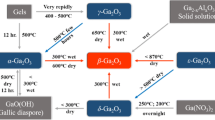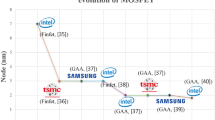Abstract
This study investigated the position of electrons and holes in the ON and OFF states of double-gate junctionless transistors, and then three structures were proposed to create an electron-filled region exposing the drain-side inside the channel to the electron screening effect. Formation of an electron cloud in the channel and on the drain-side damps the electric field resulting from the drain voltage as the electric field passes through the electron cloud before reaching the main channel. Accordingly, in the structure with a drain-side gate, with the electric field decay introduced by the drain to the main channel, the carrier density increased compared to other structures, eventually reducing drain leakage current and improving the channel length modulation (CLM), threshold voltage, drain induced barrier lowering effect, and subthreshold slope in this structure. In the N+ pocket structure, despite the decrease in the electric field resulting from the drain voltage, the drain leakage current and the CLM were increased. In the N+ SiGe pocket structure, although the electric field resulting from the drain voltage along the channel length was reduced compared to the main structure, the drain leakage current and CLM experienced an increase. Moreover, the results showed that at low drain voltages, the drain leakage current in the N+ pocket structure was higher than that of the N+ SiGe pocket, but at high drain voltages, the order was reversed.














Similar content being viewed by others
References
S. Deleonibus, Electronic Device Architectures for the Nano-CMOS Era: from Ultimate CMOS Scaling to beyond CMOS Devices (Jenny Stanford Publishing, 2019).
R.J. Baker, CMOS Circuit Design, Layout, and Simulation Wiley, Hoboken, 2019
S. Zafar, M.A. Raushan, S. Ahmad, and M.J. Siddiqui, Semicond. Sci. Technol., 2019, 35, p 015016.
N. D. Akhavan, I. Ferain, P. Razavi, R. Yu, and J.-P. Colinge, IEEE 2011 International SOI Conference (2011).
S. Moghaddam, S.S. Ghoreishi, R. Yousefi, and H. Aderang, Superlattices Microstruct., 2020, 138, p 106239.
E. Datta, A. Chattopadhyay, and A. Mallik, J. Electron. Mater., 2020, 49, p 3309.
J.P. Duarte, M.-S. Kim, S.-J. Choi, and Y.-K. Choi, IEEE Trans. Electron Devices, 2012, 59, p 1008.
A.K. Bansal, C. Gupta, A. Gupta, R. Singh, T.B. Hook, and A. Dixit, IEEE Trans. Electron Devices, 2018, 65, p 1246.
M.A. Pavanello, A. Cerdeira, R.T. Doria, T.A. Ribeiro, F. Ávila-Herrera, and M. Estrada, Solid-State Electron., 2019, 159, p 116.
P. Bal, M.W. Akram, P. Mondal, and B. Ghosh, J. Comput. Electron., 2013, 12, p 782.
R.M.I. Abadi, and M. Saremi, J. Electron. Mater., 2017, 47, p 1091.
A. Rassekh, F. Jazaeri, M. Fathipour, and J.-M. Sallese, IEEE Trans. Electron Devices, 2019, 66, p 4653.
H. Mehta, and H. Kaur, IEEE Trans. Electron Devices, 2018, 65, p 2699.
Y.V. Bhuvaneshwari, and A. Kranti, Semicond. Sci. Technol., 2018, 33, p 115020.
G.C. Patil, V.H. Bonge, M.M. Malode, and R.G. Jain, Superlattices Microstruct., 2016, 90, p 247.
F. Larki, M.S. Islam, A. Dehzangi, M.T. Islam, and H.Y. Wong, Electronics, 2019, 8, p 538.
H.Y. Wong, N. Braga, and R.V. Mickevicius, IEEE Trans. Electron Dev., 2018, 65, p 4004.
Y. Wang, C. Shan, Z. Dou, L.-G. Wang, and F. Cao, Microelectron. Reliab., 2015, 55, p 318.
F. Jazaeri, L. Barbut, A. Koukab, and J.-M. Sallese, Solid-State Electron., 2013, 82, p 103.
A. Garg, B. Singh, and Y. Singh, AEU Int. J. Electron. Commun., 2020, 118, p 153140.
M.H.R. Ansari, N. Navlakha, J.Y. Lee, and S. Cho, IEEE Trans. Electron Dev., 2020, 67, p 1471.
S. Shreya, N. Kumar, S. Anand, and I. Amin, J. Electron. Mater., 2020, 49, p 2349.
V. Narula, and M. Agarwal, Semicond. Sci. Technol., 2019, 34, p 105014.
R.K. Baruah, and R.P. Paily, IEEE Trans. Electron. Dev., 2014, 61, p 123.
H. Mehta, and H. Kaur, Adv. Nat. Sci. Nanosci. Nanotechnol., 2019, 10, p 035013.
S. Sze, and K.K. Ng, Physics of Semiconductor Devices, 3rd edn. Wiley, Hoboken, 2006
F. Shimura, Springer Handbook of Electronic and Photonic Materials 1 (2017).
M. Tilli and A. Haapalinna, Handbook of Silicon Based MEMS Materials and Technologies 3 (2010).
F. Palumbo, C. Wen, S. Lombardo, S. Pazos, F. Aguirre, M. Eizenberg, F. Hui, and M. Lanza, Adv. Func. Mater., 2019, 30, p 1900657.
H. Bartzsch, D. Glöß, B. Böcher, P. Frach, and K. Goedicke, Surf. Coat. Technol., 2003, 174–175, p 774.
ATLAS User’s Manual, Santa Clara, CA SILVACO International, USA, 2016
C.-W. Lee, A. Afzalian, N.D. Akhavan, R. Yan, I. Ferain, and J.-P. Colinge, Appl. Phys. Lett., 2009, 94, p 053511.
Author information
Authors and Affiliations
Corresponding author
Ethics declarations
Conflict of interest
The authors declare that they have no conflict of interest.
Additional information
Publisher's Note
Springer Nature remains neutral with regard to jurisdictional claims in published maps and institutional affiliations.
Rights and permissions
About this article
Cite this article
Bavir, M., Abbasi, A. & Orouji, A.A. Reducing the Drain Leakage Current in a Double-Gate Junctionless MOSFET Using the Electron Screening Effect. J. Electron. Mater. 50, 2605–2617 (2021). https://doi.org/10.1007/s11664-021-08801-2
Received:
Accepted:
Published:
Issue Date:
DOI: https://doi.org/10.1007/s11664-021-08801-2




